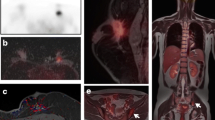Abstract
The aim of this study was to evaluate the usefulness of 99mTc-tetrofosmin single-photon emission tomography (SPET) in the detection of both primary breast cancer and axillary lymph node metastasis. We studied 192 consecutive patients in whom primary breast cancer was suspected on the basis of mammography and/or physical examination. After intravenous injection of 740 MBq 99mTc-tetrofosmin, both planar and SPET scintimammography was performed in all patients using a rectangular dual-head gamma camera equipped with low-energy, high-resolution, parallel-hole collimators. In 175 patients with breast cancer at histology, the per-lesion overall sensitivity of SPET and planar imaging for the detection of breast cancer was 95.8% and 75.9% (P<0.0005), respectively. The sensitivity of SPET and planar imaging was, respectively, 96.5% and 79.5% in palpable (P<0.0005) and 90% and 45% in non-palpable lesions (P<0.01). With regard to lesion size, the sensitivity of SPET and planar imaging was, respectively, 90.5% and 45.2% in lesions ≤10 mm (P<0.0005), 95.3% and 81.4% in lesions of 11–20 mm (P<0.005), 100% and 84.6% in lesions of 21–30 mm (P<0.05) and 100% and 95.8% in lesions >30 mm (P>0.05). In the remaining 17 patients with benign mammary lesions at histology, per-lesion overall specificity of SPET and planar imaging was 76.2% and 85.7% (P>0.05), respectively. Neither SPET nor planar imaging showed false-positive results in non-palpable lesions or in those ≤10 mm. In 173 breast cancer patients submitted to axillary lymph node dissection (ALND), per-axilla overall sensitivity of SPET and planar imaging in the detection of axillary lymph node metastasis was 93% and 52.3% (P<0.0005), respectively. The sensitivity of SPET and planar imaging was, respectively, 100% and 82.6% in palpable nodes (P>0.05), 90.5% and 41.3% in non-palpable nodes (P<0.0005), 92.8% and 35.7% in the presence of ≤3 nodes (P<0.0005) and 93.2% and 68.2% in the presence of >3 nodes (P<0.005). The specificity of SPET and planar imaging was 91% and 100% (P<0.05), respectively. 99mTc-tetrofosmin SPET appears to be a reliable method for the detection of both primary BC and axillary lymph node metastasis, and its diagnostic accuracy exceeds that of 99mTc-tetrofosmin planar scintimammography. The use of SPET is particularly important in the identification of small non-palpable primary carcinomas and metastatic axillae with ≤3 non-palpable lymph nodes. More extensive use of SPET appears warranted in the management of breast cancer patients.
Similar content being viewed by others
Author information
Authors and Affiliations
Additional information
Received 9 June and in revised form 31 August 2001
Electronic Publication
Rights and permissions
About this article
Cite this article
Spanu, A., Dettori, G., Nuvoli, S. et al. 99mTc-tetrofosmin SPET in the detection of both primary breast cancer and axillary lymph node metastasis. Eur J Nucl Med 28, 1781–1794 (2001). https://doi.org/10.1007/s00259-001-0657-5
Published:
Issue Date:
DOI: https://doi.org/10.1007/s00259-001-0657-5




